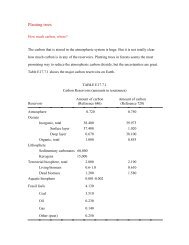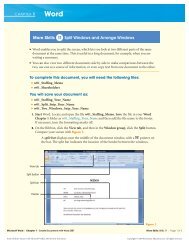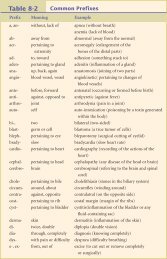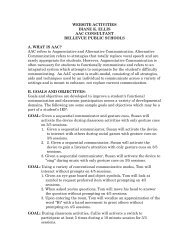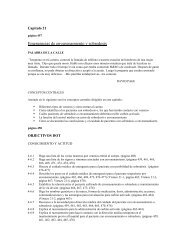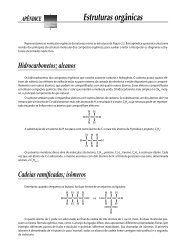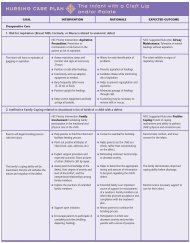chapter
chapter
chapter
You also want an ePaper? Increase the reach of your titles
YUMPU automatically turns print PDFs into web optimized ePapers that Google loves.
218 Unit Three Forces Within<br />
(4 inches) per year. The accuracy of this calculation<br />
hinges on the hot spot maintaining a fixed position in<br />
the mantle. Based on current evidence, this appears to<br />
be a reasonable assumption.<br />
Recall that the magnetic stripes measured on the<br />
floor of the ocean also provide a method to measure<br />
rates of plate motion—at least as averaged over millions<br />
of years. Using paleomagnetism and other indirect techniques,<br />
researchers have been able to work out relative<br />
plate velocities as shown on the map in Figure 7.25.<br />
It is currently possible, with the use of space-age<br />
technology, to directly measure the relative motion between<br />
plates. This is accomplished by periodically establishing<br />
the exact locations, and hence the distance<br />
between two observing stations situated on opposite<br />
sides of a plate boundary. Two of the methods used for<br />
this calculation are Very Long Baseline Interferometry<br />
(VLBI) and a satellite positioning technique that employs<br />
the Global Positioning System (GPS). The Very Long<br />
Baseline Interferometry system utilizes large radio telescopes<br />
to record signals from very distant quasars<br />
(quasi-stellar objects) (Figure 7.26). Quasars lie billions<br />
of light-years from Earth, so they act as stationary reference<br />
points. The millisecond differences in the arrival<br />
times of the same signal at different earthbound observatories<br />
provide a means of establishing the precise distance<br />
between receivers. A typical survey may take a<br />
day to perform and involves two widely spaced radio<br />
telescopes observing perhaps a dozen quasars, 5 to 10<br />
times each. This scheme provides an estimate of the distance<br />
between these observatories, which is accurate to<br />
▲<br />
▲ ▲ ▲<br />
▲ ▲ ▲ ▲<br />
Aleutian Trench<br />
▲ ▲ ▲ ▲ ▲<br />
Juan de<br />
Fuca<br />
plate<br />
Pacific plate<br />
VLBI velocities<br />
in centimeters<br />
per year<br />
1.1–2.6<br />
2.6–4.1<br />
4.1–5.5<br />
5.5–7.0<br />
>7.0<br />
▲ ▲ ▲<br />
10.8<br />
Cocos<br />
plate<br />
15.6<br />
9.4<br />
13.4<br />
East Pacific Rise<br />
North American<br />
plate<br />
▲ ▲ ▲ ▲ ▲<br />
5.0<br />
7.0<br />
Nazca<br />
plate<br />
5.9<br />
▲<br />
Peru-Chile Trench<br />
Chile Ridge<br />
▲<br />
▲<br />
▲ ▲ ▲ ▲ ▲ ▲<br />
▲ ▲ ▲ ▲ ▲ ▲<br />
Antarctic plate<br />
▲<br />
Caribbean<br />
plate<br />
▲<br />
▲<br />
▲<br />
2.3<br />
2.5<br />
1.8<br />
2.3<br />
Scotia plate<br />
Reykjanes<br />
South American<br />
plate<br />
▲<br />
Ridge<br />
Mid-Atlantic Ridge<br />
Sandwich<br />
plate<br />
Azores F.Z.<br />
▲<br />
3.5<br />
3.5<br />
Mohns<br />
Ridge<br />
about 2 centimeters. By repeating this experiment at a<br />
later date, researchers can establish the relative motion<br />
of these sites. This method has been particularly useful<br />
in establishing large-scale plate motions, such as the<br />
separation that is occurring between the United States<br />
and Europe (see Box 7.3).<br />
You may be familiar with GPS, which uses 21 satellites<br />
to accurately locate any individual who is equipped<br />
with a handheld receiver. By using two spaced receivers,<br />
signals obtained by these instruments can be<br />
used to calculate their relative positions with considerable<br />
accuracy. Techniques using GPS receivers have<br />
been shown to be useful in establishing small-scale<br />
crustal movements such as those that occur along local<br />
faults in regions known to be tectonically active.<br />
Confirming data obtained from these and other<br />
techniques leave little doubt that real plate motion has<br />
been detected (Figure 7.25). Calculations show that<br />
Hawaii is moving in a northwesterly direction and is<br />
approaching Japan at 8.3 centimeters per year. A site<br />
located in Maryland is retreating from one in England<br />
at a rate of about 1.7 centimeters per year—a rate that is<br />
close to the 2.3-centimeters-per-year spreading rate that<br />
was established from paleomagnetic evidence.<br />
▲<br />
▲ ▲<br />
The Driving Mechanism<br />
The plate tectonics theory describes plate motion and the<br />
effects of this motion. Therefore, acceptance of this<br />
model does not rely on the mechanism that drives plate<br />
motion. This is fortunate, because none of the driving<br />
▲<br />
▲ ▲ ▲<br />
▲<br />
African plate<br />
1.4<br />
▲ ▲<br />
1.5<br />
▲ ▲<br />
▲<br />
Arabian<br />
plate<br />
Eurasian plate<br />
2.7<br />
▲ ▲ ▲<br />
1.4<br />
3.0<br />
Ridge<br />
Southwest Indian Ridge<br />
Mid-Indian<br />
4.4<br />
▲ ▲ ▲ ▲<br />
7.2<br />
▲<br />
▲ ▲ ▲ ▲<br />
▲ ▲ ▲<br />
7.5<br />
▲ ▲<br />
▲<br />
▲ ▲ ▲<br />
▲ ▲<br />
▲ ▲ ▲ ▲ ▲ ▲ ▲<br />
▲ ▲<br />
Australian-Indian plate<br />
Southeast Indian Ridge<br />
Antarctic plate<br />
▲<br />
▲<br />
▲<br />
▲<br />
▲<br />
▲<br />
▲<br />
▲<br />
Philippine<br />
plate<br />
▲<br />
North American<br />
plate<br />
▲ ▲<br />
▲ ▲ ▲ ▲ ▲<br />
Figure 7.25 This map illustrates directions and rates of plate motion in centimeters per year. Seafloor-spreading velocities (as shown<br />
with black arrows and labels) are based on the spacing of dated magnetic stripes (anomalies). The colored arrows show Very Long<br />
Baseline Interferometry (VLBI) data of plate motion at selected locations. The data obtained by these methods are typically consistent.<br />
(Seafloor data from DeMets and others, VLBI data from Ryan and others.)<br />
Somalia<br />
plate<br />
Java Trench<br />
▲<br />
Mariana Trench<br />
▲<br />
Caroline<br />
plate<br />
▲<br />
Pacific<br />
plate<br />
▲ ▲<br />
▲<br />
▲ ▲<br />
▲<br />
▲<br />
▲ ▲ ▲<br />
▲ ▲<br />
Alpine F.<br />
▲<br />
▲ ▲




